History of United States foreign policy facts for kids
The history of United States foreign policy is about how the U.S. has dealt with other countries from its beginning until today. Key ideas include becoming an "Empire of Liberty" (a nation that promotes freedom), spreading democracy, and expanding across the continent. The U.S. also supported liberal internationalism (working with other nations for peace). It fought in World Wars and the Cold War, battled international terrorism, helped developing countries, and built a strong world economy.
Contents
- A New Nation: 1776–1801
- Jefferson's Vision: 1801–1829
- Expansion and New Challenges: 1829–1861
- Civil War and the Gilded Age: 1861–1897
- Becoming a Global Power: 1897–1913
- Wilson and World War I
- Between the World Wars: 1921–1933
- Roosevelt, World War II, and Aftermath: 1933–1947
- The Cold War: 1947–1991
- After the Cold War: 1992–Present
- Soft Power
- Diplomats
A New Nation: 1776–1801
Revolution and Early Years

When the United States was formed, its main focus was on its own region. But it also dreamed of creating an "Empire of Liberty." This meant spreading ideas of freedom and self-government.
In 1778, the U.S. formed an alliance with France. This brought Spain and the Netherlands into the fight against Britain. It turned the American Revolutionary War into a global conflict. American diplomats like Benjamin Franklin, John Adams, and Thomas Jefferson helped secure independence. They also got large loans for the new government. The Treaty of Paris in 1783 was very good for the U.S. It allowed the country to expand westward to the Mississippi River.
From 1776 to 1789, Congress handled foreign affairs. After the new Constitution in 1789, the Department of Foreign Affairs was created. It was soon renamed the Department of State. Thomas Jefferson became the first Secretary of State.
Staying Neutral and Facing Challenges
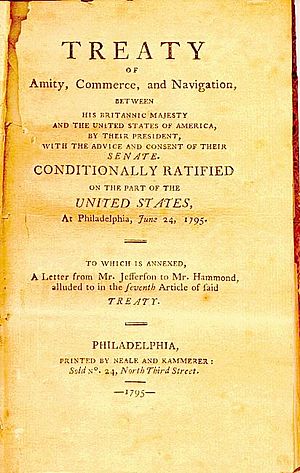
In 1793, the French Revolution led to war between Britain and France. Britain was America's main trading partner. France was an old ally with a treaty still in place. President George Washington and his team decided to stay neutral. This policy was made law in the Neutrality Act of 1794.
In 1795, Washington supported the Jay Treaty. This treaty, planned by Alexander Hamilton, aimed to avoid war with Britain. It also encouraged trade. Many, especially Thomas Jefferson and James Madison, strongly opposed it. But Washington's support made it happen. The U.S. and Britain were friendly for ten years. However, this foreign policy debate caused political parties to form at home.
In 1796, President George Washington gave a "Farewell Message." It became a key part of U.S. policy. He advised against getting too involved in foreign conflicts. He said Europe had its own problems that didn't concern the U.S. He believed America's distance allowed it to follow a different path.
By 1797, France began seizing American ships. This led to an undeclared war called the Quasi-War (1798–99). President John Adams tried diplomacy, but it failed. In 1798, French officials demanded bribes from American diplomats. The Americans refused. This event, known as the XYZ Affair, made Americans very angry. Congress approved Adams' plan to build up the navy. Public opinion turned against France. Adams made peace with France in 1800.
Jefferson's Vision: 1801–1829
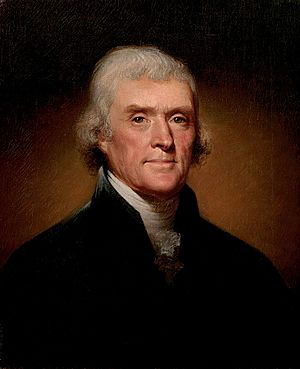
President Thomas Jefferson dreamed of America leading a great "Empire of Liberty." He wanted to spread republicanism and challenge British power. In 1803, Jefferson made the Louisiana Purchase from Napoleon Bonaparte for $15 million. This deal doubled the size of the U.S. It opened up vast new lands for farmers.
Jefferson tried to use trade to influence Europe. His Embargo Act of 1807 stopped trade with both France and Britain. But it didn't work. It was very unpopular in New England and hurt American businesses.
The War of 1812
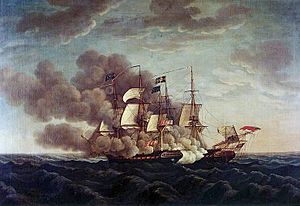
Americans deeply distrusted the British. Britain blocked most American trade with France. British ships also captured about 6,000 American sailors and forced them into the Royal Navy. This act, called impressment, angered Americans. An attack on the American warship Chesapeake in 1807 further humiliated the U.S.
In the west, Native American tribes, supported by Britain, attacked settlers. This slowed down American expansion. In 1812, the U.S. declared war on Britain. The War of 1812 ended with the Treaty of Ghent in 1815. The war was a military tie. Both sides failed in their invasion attempts. However, the British achieved their goal of defeating Napoleon in Europe. American armies defeated the Native American alliance that Britain had supported. This ended Britain's goal of creating a pro-British Native American nation in the Midwest.
After 1815, tensions along the U.S.-Canada border decreased. Trade was peaceful, and relations were good. Boundary disputes were settled calmly. Both the U.S. and Canada felt a surge of national pride after 1815.
Latin America and the Monroe Doctrine
In 1821, many Spanish colonies in Latin America gained independence. In response, the U.S., with Britain's help, created the Monroe Doctrine in 1823. This policy stated that European countries should not interfere in the Americas. It greatly influenced future American leaders. Florida was bought by the U.S. in 1821 after Spain failed to control it. John Quincy Adams was Secretary of State at this time.
Expansion and New Challenges: 1829–1861
The Mexican-American War
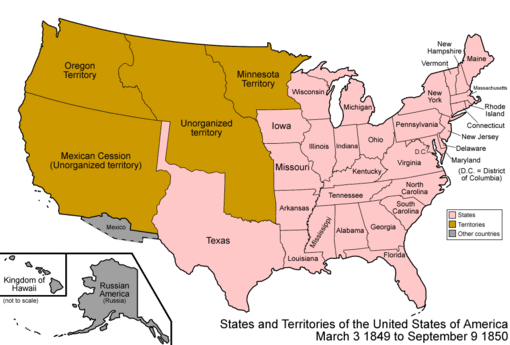
In 1846, after much debate, the U.S. added the Republic of Texas. Mexico had never accepted Texas's independence and warned of war if the U.S. annexed it. President James K. Polk peacefully settled a border dispute with Britain over Oregon. Then, he sent U.S. Army patrols into the disputed area of Texas. This led to the Mexican–American War, which the U.S. easily won.
As a result of the Treaty of Guadalupe Hidalgo in 1848, the U.S. gained vast territory. This included California, Arizona, and New Mexico. Hispanic residents living there became full U.S. citizens.
The Idea of a Canal
The discovery of gold in California in 1848 created a huge demand for faster travel to the west. People wanted to avoid the long sea voyage around South America. A canal through Nicaragua seemed like a good idea. American businessman Cornelius Vanderbilt got permission for it. Britain, which had long influenced Central America, tried to block an American canal.
In 1850, the U.S. and Britain reached a diplomatic solution. The Clayton–Bulwer Treaty stated that neither nation would build a canal without the other's consent. It also said neither would fortify or colonize the region. If a canal was built, it would be neutral for all shipping. However, no Nicaragua canal was ever started.
The completion of the transcontinental railroad in 1869 made travel to California fast and safe. Americans lost interest in canals for a while. Britain focused on building the Suez Canal in Egypt. Later, in the 1890s, the French tried to build a canal in Panama, but it failed. By the late 1890s, Britain allowed the U.S. to build a canal. The Hay–Pauncefote Treaty of 1901 replaced the earlier treaty. The U.S. built the Panama Canal, which opened in 1914.
President Buchanan's Foreign Policy
President James Buchanan (1857-1861) had a lot of foreign policy experience. He wanted to increase American influence in Central America. He also hoped to buy Cuba, where slavery still existed. However, Congress, especially anti-slavery forces, blocked his plans to acquire new slave territories.
Buchanan tried to buy Alaska from Russia. But the U.S. and Russia couldn't agree on a price. In China, Buchanan's administration gained trade benefits. The Treaty of Tientsin (1858) allowed American diplomats to live in Peking. It also lowered tariffs for American goods. This treaty helped set the stage for the later Open Door Policy.
Civil War and the Gilded Age: 1861–1897
The American Civil War
During the American Civil War, all other nations officially stayed neutral. None recognized the Confederacy. This was a big win for Secretary William H. Seward and President Lincoln. France, under Napoléon III, had invaded Mexico. It hoped to reduce American influence. France encouraged Britain to recognize the Confederacy. But Washington warned that this would mean war.
Britain's textile industry relied on cotton from the South. But Britain also needed American food. A war would stop food shipments and hurt British trade. Britain refused to join France's plans.
At first, American diplomats struggled to explain the Union's goals. They talked about the Constitution, not ending slavery. Confederate spokesmen, however, focused on liberty and free trade. They also highlighted cotton's importance to Europe. European leaders often hoped the American experiment in democracy would fail.
Public opinion in Britain generally favored the United States. Trade continued between the U.S. and Britain. After the Emancipation Proclamation in September 1862, the war became about ending slavery. Most British people supported this.
A serious dispute happened in late 1861, called the "Trent Affair." The American navy seized Confederate diplomats from a British ship. Lincoln, however, returned the diplomats.
The Union's victory had a huge impact on world history. It showed that democratic government could last. A Confederate victory might have led to more slavery and repression.
Alaska and Canada
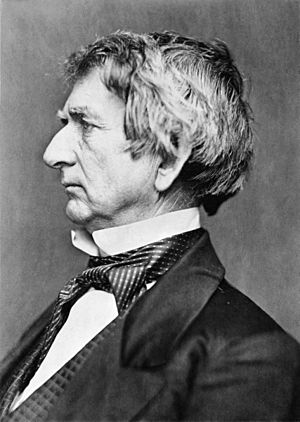
Secretary of State William H. Seward wanted the U.S. to expand. In 1867, Russia feared a war with Britain. It decided to sell its Alaska colony to the U.S. for $7.2 million. This was a great deal. It gave the U.S. a strong presence in the North Pacific. It also stopped Britain from expanding there. Alaska didn't get much attention until gold was discovered in the 1890s.
Relations with Britain and its Canadian colonies were tense. British shipyards built warships for the Confederacy, like the CSS Alabama. The U.S. demanded that Britain pay for the damages caused by these ships. Negotiations lasted for years. In 1872, the dispute was peacefully settled by an international court. The U.S. received $15.5 million.
Britain decided to reduce its military presence in North America. It brought its troops home and let the Canadian colonies manage their own defense. This led to the unification of Canadian colonies into the self-governing Dominion of Canada.
James G. Blaine and Hawaii
James G. Blaine was a key Republican leader and Secretary of State in the 1880s. He wanted to promote freer trade, especially in the Western Hemisphere. He believed this would increase American wealth and reduce British influence. Blaine called for a Pan-American conference in 1882. It aimed to settle disputes among Latin American nations and boost trade. He also wanted the U.S. to build a canal through Panama without British involvement.
Blaine also worked for closer ties with the Hawaiian Kingdom. He sponsored a program to bring together all independent nations of the Western Hemisphere. This became the Pan-American Union.
Before 1892, top diplomats were called "ministers." In 1892, major European countries began calling their chief diplomats to the U.S. "ambassadors." The U.S. did the same in 1893.
Hawaii and American Influence
In 1893, the business community in Hawaii overthrew the Queen. They wanted the U.S. to annex Hawaii. President Benjamin Harrison supported this. But the new President, Grover Cleveland, opposed expansion. He withdrew the annexation proposal. Hawaii then formed an independent Republic of Hawaii.
Foreign policy suddenly became a big issue in American politics. Public opinion began to favor the U.S. joining other world powers in gaining overseas colonies. Cleveland, however, was against taking over the small kingdom. He sent a special representative to Hawaii to investigate. This representative, James Henderson Blount, opposed imperialism. He called for the U.S. military to restore Queen Liliʻuokalani. Cleveland wanted to restore the Queen. But when she threatened to execute the Hawaiian leaders, he pulled back. The Republic of Hawaii was recognized by other nations.
Becoming a Global Power: 1897–1913
Expansionists Win Out
A strong movement against expansion grew in the U.S. It was called the American Anti-Imperialist League. They believed that taking colonies went against American ideals of self-government. They argued it would mean giving up principles from the Declaration of Independence and George Washington's Farewell Address.
However, expansionists like Secretary of State John Hay, naval strategist Alfred Thayer Mahan, and Theodore Roosevelt pushed for expansion. They had strong support from newspapers. Mahan and Roosevelt wanted a modern navy, Pacific bases, and a canal. They believed America should play a strong role as the biggest industrial power. President McKinley argued that Hawaii couldn't survive alone. He said Japan would take it over. McKinley annexed Hawaii in 1898 through a joint resolution of Congress. Hawaii became a territory in 1898 and a state in 1959.

In 1900, the U.S., with British support, announced the Open Door Policy. This policy aimed to give all nations equal access to trade in China.
Cuba and Spain
In the mid-1890s, Americans were upset by Spain's harsh treatment of the Cuban independence movement. When the American battleship USS Maine exploded in Havana harbor in 1898, many demanded war. The U.S. easily won the four-month-long Spanish–American War. In the Treaty of Paris, the U.S. took over Cuba, Puerto Rico, the Philippines, and Guam. This marked America's shift from a regional to a global power. Cuba gained independence under American supervision.
The U.S. Navy became a major power. The Army was also reorganized. The Philippine–American War was fought to control the islands. By 1907, U.S. foreign policy focused more on the Caribbean. The 1904 Roosevelt Corollary to the Monroe Doctrine gave the U.S. the right to intervene in weak states in the Americas. This further reduced European influence in Latin America.
The Mexican Revolution in 1910 caused problems. Revolutionaries threatened American businesses. Hundreds of thousands of refugees fled north. President Woodrow Wilson tried military intervention, but it failed. After Mexico rejected Germany's offer to join a war against the U.S. in 1917, relations improved. Military interventions in other small countries, like Nicaragua, ended with President Franklin D. Roosevelt's Good Neighbor policy in 1933. This policy allowed the U.S. to be friends with dictatorships.
Wilson and World War I
From Neutrality to War
President Woodrow Wilson largely shaped American foreign policy. He believed in liberal internationalism, which meant working with other nations for peace. This was different from the more realistic approach of past presidents.
The U.S. military intervened in many Latin American nations. This was done to stabilize governments, promote democracy, and protect trade. For example, U.S. troops landed in Mexico, Haiti, and the Dominican Republic.
When World War I began in 1914, the U.S. declared neutrality. It tried to help make peace. The U.S. insisted on its right to trade with both sides. But the British blockade meant almost all trade went to the Allies. German actions, like sinking the RMS Lusitania in 1915, angered Americans. This attack killed 128 American civilians. American opinion turned strongly against Germany.
Germany apologized and promised to stop U-boat attacks. But in early 1917, it resumed unrestricted submarine warfare. It also tried to get Mexico to join a war against the U.S. in the Zimmermann Telegram. After more American ships were sunk, Wilson asked Congress for a declaration of war in April 1917. He argued it was a war to end aggressive militarism and all wars. The U.S. was not officially tied to the Allies by treaty. But its military help became very important by mid-1918.
Fighting for Peace
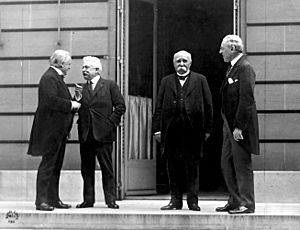
At the peace conference at Versailles, Wilson tried to put his Fourteen Points into action. He had to accept demands from Britain, France, and Italy for Germany to pay reparations. Germany also had to admit guilt for the war. This was a harsh punishment for Germany.
Wilson's main goal was to create a League of Nations. He hoped it would prevent future major wars. However, Wilson refused to work with Republicans in Congress. They wanted changes to protect Congress's right to declare war. The Senate did not approve the treaty, so the U.S. never joined the League.
Despite this, Wilson's ideas of self-determination for all nations influenced people worldwide. His vision, called "Wilsonianism," of spreading democracy and peace under American leadership, has deeply influenced U.S. foreign policy ever since.
Between the World Wars: 1921–1933
In the 1920s, the U.S. was active in international affairs. But it ignored the League of Nations. It used its financial power to influence major diplomatic issues in Europe. There were also large humanitarian aid missions. Herbert Hoover led efforts to provide food aid in Belgium, Germany, and Russia. The U.S. also helped Japan after a major earthquake in 1923.
Republican presidents like Warren Harding, Calvin Coolidge, and Herbert Hoover avoided political alliances. They focused on American involvement in reparations and disarmament. They wanted to use American influence to help Europe settle quarrels peacefully. They also sought disarmament agreements and stronger European economies.
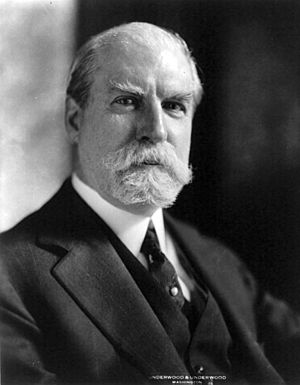
The Washington Naval Conference (1921–1922) was a big diplomatic success. It was led by Secretary of State Charles Evans Hughes. Nine nations attended, including the U.S., Japan, China, Britain, and France. The conference focused on issues in the Pacific and East Asia. Its main achievement was a series of naval disarmament agreements. These treaties helped keep peace for a decade.
The Dawes Plan
The Dawes Plan in 1924 was an American solution to the reparations crisis. France was demanding more money from Germany than Germany could pay. This led to France occupying Germany's industrial Ruhr region. The Dawes Plan, sponsored by American Charles G. Dawes, created a new financial system. New York banks loaned Germany money to pay reparations and rebuild its industry. France and Britain then used these reparations to repay their wartime loans to the U.S.
In 1928, Germany asked for a new payment plan. This led to the Young Plan. It set Germany's reparations at $26.3 billion. But with the collapse of the German economy in 1931, payments were stopped.
Ending Interventions in Latin America
Small military interventions in Latin America, known as the Banana Wars, slowly ended after 1921. The Hoover administration began a goodwill policy and pulled out all military forces. President Roosevelt announced the "Good Neighbor policy" in 1933. This meant the U.S. would no longer intervene to promote good government. Instead, it would accept whatever governments were chosen locally.
Roosevelt, World War II, and Aftermath: 1933–1947
Spanish Civil War: 1936–1939
In the 1930s, the U.S. largely stayed out of international conflicts. When the Spanish Civil War started in 1936, the U.S. remained neutral. It banned arms sales to both sides. This was in line with U.S. neutrality and a European agreement to prevent the war from spreading.
President Roosevelt quietly favored the left-wing Republican government. But strong pressure from American Catholics forced him to stay neutral. Catholics were upset by the torture and execution of priests and nuns by some elements of the Republican side.
Germany and Italy supported the Nationalists, led by Francisco Franco. The Soviet Union helped the Republican government. By 1938, Roosevelt considered secretly sending warplanes to the Republicans. But his diplomats warned this would worsen the European crisis. So, Roosevelt stopped the plan.
Adolf Hitler and Franco did not like each other. Franco often used Hitler for his own benefit during World War II. Franco also protected Jewish refugees escaping through France.
Coming of World War II: 1937–1941
President Roosevelt tried to avoid the mistakes of World War I. He made it clear his administration favored Britain and China. Unlike the loans in World War I, the U.S. gave large amounts of military and economic aid to the Allies through Lend-Lease. This aid was given with little expectation of repayment. Roosevelt also expanded war production before the U.S. officially entered the war. He started a military draft in 1940.
Wilson had kept the U.S. separate from the Allies. But Roosevelt made the U.S. a full ally. Wilson never met with top Allied leaders, but Roosevelt did. Wilson proclaimed an independent policy. Roosevelt always worked closely with the Allies. In 1917, the U.S. declared war on Germany. In 1941, Roosevelt waited until the enemy attacked at Pearl Harbor.
The Attack on Pearl Harbor
On December 7, 1941, Japan launched a surprise attack on Pearl Harbor, Hawaii. All American intelligence agencies failed to predict it. Japan's plans were a very closely guarded secret. The attack fleet kept radio silence and was not seen. The U.S. had cracked Japan's diplomatic code. But the Japanese Foreign Ministry was not told about the attack. So, American intelligence couldn't find secrets through that.
American intelligence expected attacks on British and Dutch territories. They focused on predicting local sabotage at Pearl Harbor. There was no single American intelligence center until 1942. Information from the Army, Navy, and State Department was not coordinated. After the attack, investigators found many small clues that pointed to it. But at the time, there was too much confusion and poor coordination to predict the attack.
World War II and Its Aftermath
The U.S. officially entered World War II in December 1941. It fought against Germany, Japan, and Italy. This time, the U.S. was a full member of the Allies of World War II. It fought on both the Atlantic and Pacific fronts. After the war, the U.S. was in a very powerful position. Its European and Asian rivals were devastated. The U.S. had enormous economic and military strength.
President Roosevelt and his top aide, Harry Hopkins, handled major diplomatic decisions. These included relations with Britain, the Soviet Union, France, and China.
Postwar Peace and the United Nations
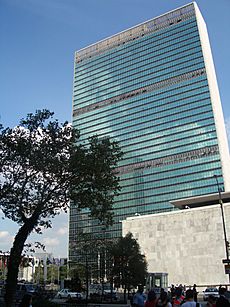
After 1945, the U.S. ended its isolationist policy for good. Roosevelt wanted a new international organization. He hoped it would be more effective than the old League of Nations. He successfully supported the creation of the United Nations.
The United Nations
The U.S. played a big role in forming the United Nations in 1945. It hosted a meeting of fifty nations in San Francisco. The U.S., Soviet Union, Britain, France, and China became permanent members of the United Nations Security Council. They had veto power. The U.N. aimed to promote world peace through agreement among nations. It could use boycotts, sanctions, and even military force.
The Cold War: 1947–1991
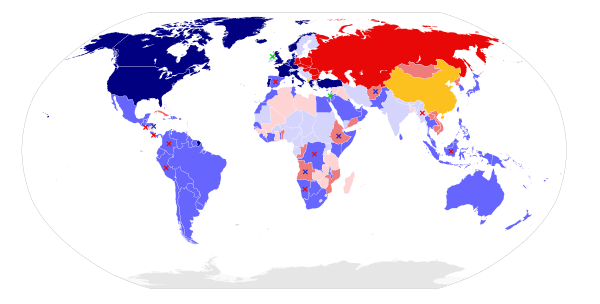
Truman and Eisenhower
From the late 1940s until 1991, the world was dominated by the Cold War. The U.S. and its allies faced the Soviet Union and its allies. There was no large-scale direct fighting between them. But there were many regional wars and the constant threat of nuclear war.
Before the Korean War in 1950, the Truman Administration focused on strengthening non-Communist states. This included Western Europe and Japan. In 1948, the U.S. launched the Marshall Plan. It gave Western Europe $13 billion for rebuilding. The U.S. also helped restore Japan's economy. The U.S. actively sought allies. It gave them military and economic aid. A key step was forming the North Atlantic Treaty Organization (NATO) in 1949. This committed the U.S. to defend Western Europe.
The U.S. developed a strategy called containment. This aimed to stop the spread of communism. George F. Kennan developed this policy in 1947. He saw the Soviet Union as an aggressive power. Containment meant matching Soviet aggression with force wherever it happened. It avoided using nuclear weapons. This policy created a tense global competition between the U.S. and the Soviet Union.
The Cold War had no global wars. But it had many regional proxy wars. These were often fought between smaller states supported by the U.S. and the Soviet Union. The U.S. also intervened in other countries' affairs through secret operations.
The Containment policy led the U.S. and its allies into the Korean War (1950–1953). It was a stalemate. The Vietnam War (1963–75) was longer and more difficult. Under President Jimmy Carter, the U.S. supported anti-Soviet forces in Afghanistan. This created problems for the Soviet Union.
Kennedy and Johnson: 1961–1969

The Cold War became most dangerous during the Kennedy administration. This was during the Cuban Missile Crisis in 1962. It was a tense standoff over Soviet nuclear missiles in Cuba. The crisis lasted thirteen days. It was the closest the world came to a nuclear war. Kennedy decided not to invade Cuba. Instead, he set up a naval blockade. The crisis ended with a compromise. The Soviets removed their missiles publicly. The U.S. secretly removed its nuclear missiles in Turkey.
Historians disagree about Kennedy's overall foreign policy. But they generally agree he succeeded on smaller issues. He helped calm the crisis in Laos. He was careful about the Congo. He liberalized trade. He led humanitarian efforts, like the Peace Corps. He helped solve a dispute between Indonesia and the Netherlands. He achieved the Limited Test Ban Treaty. He defended Berlin and strengthened European defenses. His willingness to talk with Nikita Khrushchev eased the Berlin crisis. Kennedy's personal diplomacy earned him respect from leaders in developing countries.
When Lyndon Johnson became president in 1963, his main focus was domestic policy. He tried to keep the Vietnam War quiet. American troops in Vietnam grew from 16,000 in 1963 to over 500,000 in 1968. Johnson refused to use Army reserves or the National Guard. This would have involved Congress. Instead, he relied on the draft, which became very unpopular.
In August 1964, Johnson got Congress to pass the Gulf of Tonkin Resolution. This gave him broad power to use military force. In February 1968, the Viet Cong launched the Tet Offensive. South Vietnam's army fought off the attacks. But the Tet Offensive was a public relations disaster for Johnson. Americans realized they were deeply involved in a war few understood.
The antiwar movement began in 1964. Some opposed the war for moral reasons. Opposition was strong among civil rights activists and college students.
Nixon and Ford: 1969–1977
President Richard Nixon (1969–74) greatly changed American policy. With his advisor Henry Kissinger, he rejected the long-standing containment policy. He played the two main communist rivals, China and the USSR, against each other. This led to a period of reduced tension called Détente. Moscow and Beijing agreed to stop supporting Vietnam. This allowed Nixon to turn the war over to South Vietnam. He withdrew all American troops. This "Vietnamization" policy seemed to work until 1975. Then, North Vietnam conquered South Vietnam without U.S. intervention.
The Nixon Doctrine
The Nixon Doctrine, announced in 1969, shifted responsibility for defense to the allies themselves. The U.S. would provide diplomacy, financial aid, and training. But the threatened nation would provide the soldiers. This was a clear rejection of sending 500,000 American soldiers, as in Vietnam. A major goal was to reduce tension with the Soviet Union and China.
The doctrine was applied in Asia, including Iran, Taiwan, Cambodia, and South Korea. The U.S. turned to Saudi Arabia and Iran as key partners for regional stability. Oil price increases in the 1970s allowed these states to fund military expansion.
India, Pakistan, and Bangladesh, 1971
In 1971, a war for independence broke out in East Pakistan. India joined in to defeat Pakistan, an American ally. Nixon sent a carrier group to the Bay of Bengal to show support for Pakistan. But there was no combat. Nixon and Kissinger saw India's alliance with the USSR as a threat. Pakistan was important for secret talks with China. Nixon feared an Indian invasion of West Pakistan would risk Soviet control of the region. To show China that the U.S. was a reliable ally, Nixon sent military supplies to Pakistan. In the end, Pakistan lost, and Bangladesh became independent. But the USSR did not expand its control.
Carter: 1977–1981
Democrat Jimmy Carter became president in 1977. His foreign policy faced many challenges. These included a proxy war against the Soviet Union in Afghanistan. He also faced a confrontation with the new anti-American government in Iran. Carter had little foreign policy experience. He struggled to stop disagreements between his top advisors.
Secretary of State Cyrus Vance negotiated the Panama Canal Treaties. He also worked on peace talks in Rhodesia, Namibia, and South Africa. Vance helped secure the Camp David Accords in 1978 between Israel and Egypt. He strongly supported disarmament.
National Security Advisor Zbigniew Brzezinski was a hard-liner against communism. He pushed for a tougher policy towards the Soviets. He also successfully pushed for normal relations with People's Republic of China in 1978. When revolution broke out in Iran in 1978, Vance and Brzezinski disagreed on how to support the Shah. Vance resigned in 1980 after the failed mission to rescue American hostages in Iran.
Reagan: 1981–1989
President Ronald Reagan rejected détente and containment. He aimed to win the Cold War by destroying Soviet communism. He called Moscow the "evil Empire." His main action was a huge increase in military spending. He invested heavily in high-tech weapons. The Soviets could not match this. After fierce political battles, Reagan placed medium-range missiles in Western Europe. These were aimed at the Soviet Union.
Reagan's administration made defense spending a top priority. It increased by 34 percent between 1981 and 1985. There were also major arms sales to allies. A notable sale in 1981 was $8.5 billion to Saudi Arabia. It included aircraft and tanks.
At first, Reagan's administration was suspicious of arms control. But after the military buildup, it favored them. Reagan achieved major arms reductions with Mikhail Gorbachev. This was possible because Gorbachev came to power in 1985. He was committed to saving communism in the Soviet Union. He negotiated compromises with Reagan that weakened Soviet power.
In 1989, all the East European countries revolted and ended Moscow's control. West Germany absorbed East Germany. In 1991, Russia overthrew communism. The Soviet Union dissolved at the end of the year. The U.S. and NATO had won the Cold War. This left the United States as the world's only superpower.
George H. W. Bush: 1989–1993
Unlike Reagan, President George H. W. Bush focused on caution and careful management. His main foreign policy advisors were James Baker and Brent Scowcroft. Bush had a lot of foreign policy experience. He had been an ambassador to China and the United Nations. He was also director of the CIA.
Major world events during Bush's presidency included:
- The crushing of the 1989 Tiananmen Square protests and massacre in China.
- The United States invasion of Panama in December 1989.
- The signing of the START I and START II treaties for nuclear disarmament with the USSR.
- The Gulf War in 1991, where Bush led a large group of nations to defeat Iraq. Iraq had invaded Kuwait.
- The victory in the Cold War over Soviet communism.
- The Revolutions of 1989 and the collapse of Communism in Eastern Europe.
- German reunification in 1990.
- The dissolution of the Soviet Union in 1991. It was replaced by a friendly Russia and 14 other countries.
Most of these events were good for the U.S. Bush took action in Panama and with the START treaties. Otherwise, he mostly observed events. Scholars generally praise Bush's foreign policy. But they criticize his unwillingness to strongly condemn the Tiananmen Square crackdown. He believed long-term good relations with China were too important.
After the Cold War: 1992–Present
A Favorable World Scene
For the first time since the 1930s, the international situation was very good. Old enemies like the Soviet Union had collapsed. Other problems seemed less urgent. President Bill Clinton focused mostly on domestic issues.
After the successful Gulf War in 1991, some scholars said the U.S. lacked a new foreign policy vision. They felt many opportunities were missed. In the 1990s, the U.S. reduced its foreign policy and defense budgets. It focused on economic growth at home. The U.S. also acted as a peacekeeper in ethnic conflicts in the former Yugoslavia.
Historians agree that foreign policy was not a top priority for the Clinton administration (1993-2000). However, the U.S. strengthened its alliances. It brought three former Warsaw Pact members into NATO. It prepared for competition with a rising China. It also insisted on leading its alliances. The U.S. and its NATO allies claimed the right to intervene in other states' territories. This was sometimes done without United Nations approval.
Global War on Terrorism
A decade of economic growth ended with the September 11, 2001 attacks. Terrorists from Al-Qaeda attacked the World Trade Center in New York City. This surprise attack led to a big change in U.S. foreign policy. The focus on domestic prosperity shifted to unilateral action under President George W. Bush. This was to fight the growing threat of fundamentalist terrorism in the Middle East.
The U.S. declared a War on Terrorism. This policy dominated U.S. foreign policy for over a decade. The nation launched two military campaigns in the Middle East: in Afghanistan and Iraq. Both campaigns received international support, especially in Afghanistan. However, the length of the war reduced support from American allies. Also, when no WMDs (Weapons of Mass Destruction) were found in Iraq, many doubted the war was fought to prevent terrorism. The war in Iraq hurt the U.S. image worldwide.
The "Bush Doctrine" aimed to spread liberal political institutions and democratic values. This policy helped inspire democratic uprisings in the Middle East. But it often led to anti-democratic results.
The world shifted from a bipolar (two-power) world to a multipolar (many-power) world. The U.S. remains strong economically and militarily. But rising nations like China, India, Brazil, and Russia have challenged its dominance.
President Barack Obama tried to improve relations with the Muslim world. But American foreign policy continued to cause problems with some Muslim nations, including Pakistan. Serious issues remain for the U.S. The Middle East still faces religious hatred and conflict. The danger of nuclear proliferation is clear with nations like Iran and North Korea building nuclear weapons. Global issues like climate change also present tough diplomatic challenges.
New Directions Under President Trump
President Donald Trump's foreign policy was very controversial. He rejected many agreements made by President Obama. These included the "Trans-Pacific Partnership" trade deal. He pulled out of the Paris climate accord. He also left the Joint Comprehensive Plan of Action to stop Iran's nuclear weapons development.
Trump imposed tariffs on Canada, Mexico, Europe, and other nations. He started an escalating trade war with China. His relations with North Korea's leader, Kim Jong-un, changed from hostility to personal friendship. Trump tried to reduce entry of Muslims and Mexicans into the U.S. He also tried to limit asylum-seekers from Latin America.
Trump strongly supported Saudi Arabia and Israel. He strongly opposed the governments of Iran and Venezuela. Businesses generally liked his domestic tax cuts. But they strongly opposed his trade policy, especially the trade war with China.
Richard Haass noted that the Trump administration reversed many key American positions. These included support for alliances, free trade, and concern over climate change. He also questioned American leadership itself.
The U.S. as an "Empire"?
The U.S. was founded as the first successful revolt against a major empire in 1776. Historically, it has opposed imperialism. This was seen in the Monroe Doctrine and the war against the Spanish Empire in 1898. It also supported dissolving the British and Dutch empires after 1945. Thomas Jefferson called for an "empire of liberty." This meant the U.S. would lead the way to Republicanism.
In 1898–1900, there was a big debate. Anti-imperialists fought against taking control of the Philippines after Spain left. They argued the U.S. should not follow in the footsteps of old empires. But President McKinley decided America had responsibilities and insisted on taking the Philippines. Congress decided not to take ownership of Cuba. Any excitement about being an imperial power was short-lived. By 1905, U.S. interests shifted to the Panama Canal. The Philippines became independent in 1946.
However, during the Cold War and after 9/11, some critics said the U.S. had become its own worldwide empire. In 1945, the U.S. planned to withdraw its forces from Europe. But Soviet actions in Eastern Europe and Greece forced a change. U.S. policymakers decided the Soviet Union was a threat. They believed containing its growth would bring stability. This led to the Truman Doctrine (1947).
Another reason was the need to rebuild the world economy. This was a main reason for the Marshall Plan of 1948. European nations also realized they needed American military involvement. Historians have noted how eagerly America's friendship and leadership were sought. In Western Europe, America built an empire "by invitation."
Many scholars believe the U.S. lacks the key features of an empire. For example, American soldiers do not rule local people. The U.S. government does not send out governors or permanent settlers like historic empires did. Historian Charles S. Maier says the U.S. does not exert formal control over other nations. He calls the U.S. a "hegemon." Its huge influence comes from technology, economic power, and popular culture. This gives it a global reach that is different from old empires.
Soft Power
The Foreign relations of the United States has long used "soft power." This means influencing others through culture, values, and ideas, rather than military force. Examples include Franklin D. Roosevelt's Four Freedoms in World War II. People behind the Iron Curtain listened to Radio Free Europe. Newly freed Afghans in 2001 asked for copies of the Bill of Rights. Young Iranians today secretly watch banned American videos.
America's early commitment to religious toleration attracted immigrants. American aid to rebuild Europe after World War II showed the prosperity and generosity of the U.S.
Studies show that U.S. soft power efforts during the Cold War helped lead to the collapse of the Soviet Union. Satellite TV also promotes American soft power in the Arab world. Channels like Alhurra provide news and entertainment. Radio Sawa and Radio Farda play light news and American popular music. These efforts have gained many listeners in their target regions.
Diplomats
Historically, diplomacy was mostly a man's job. But a diplomat's wife was also very important. She had to project a proper image of American society. This meant maintaining a nice household and entertaining guests. She also gathered informal information. The wife needed to fit into the high society of European diplomacy. Having family money helped a lot, as diplomatic pay was modest.
Frances E. Willis (1899–1983) was a famous pioneer. She was one of the first women in the foreign service. She was the first woman appointed ambassador (to Switzerland in 1953). She later served as ambassador to Norway and Ceylon. She was known for her skills, hard work, and confidence.
Today, high-profile ambassadorships often go to political or financial supporters of the president. These people are usually sent to Western Europe or countries with strong economic ties to the U.S. Professional career ambassadors move up through the State Department. They are typically sent to smaller countries.
|


